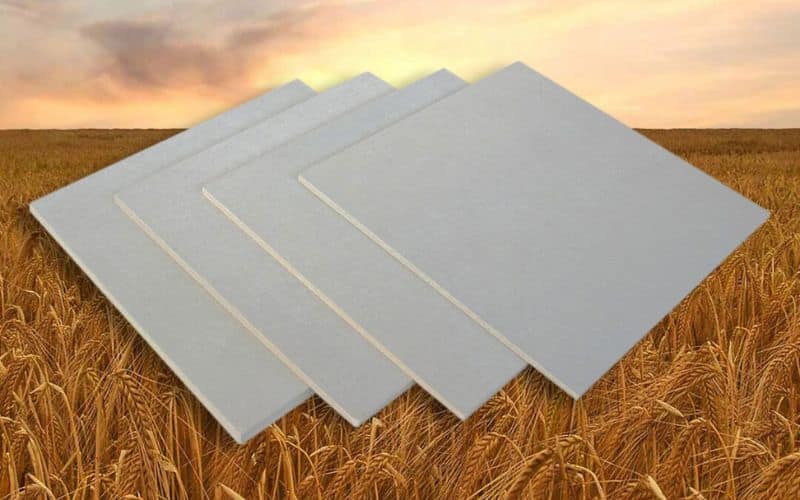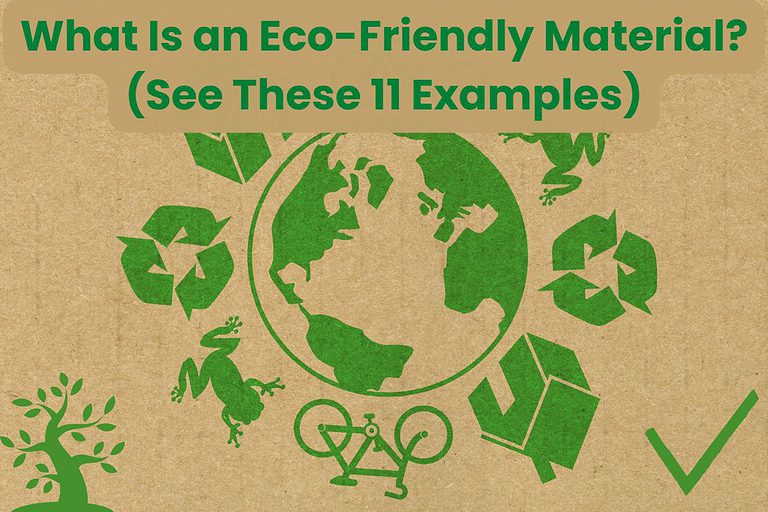10 of the Most Non-toxic Sustainable Building Materials

The world of sustainable building is growing quickly, thanks to the advancement in green building materials and technologies now available to support eco-friendly construction.
The demand for non-toxic, sustainable building materials is increasing, too, thanks to greater awareness of the benefits of this mode of building from the general public and the construction industry.
As a homeowner looking to build a green home that supports your family’s health and wellness, the sheer variety of green products on the market can be daunting.
An appropriate way to approach this dilemma is to go for the most non-toxic, eco-friendly building materials your project allows to conserve the environment while protecting your family’s health.
It’s worth noting that some green building materials marketed as “sustainable” may be safer for the environment and not humans.
Such materials may contain toxic chemicals like formaldehyde, Volatile Organic Compounds (VOCs), and PVCs, known to cause respiratory problems and other health issues.
In this article, I’ll discuss 10 of the most non-toxic and eco-friendly materials.
Besides protecting the steady-state equilibrium of the environment, these materials don’t emit harmful substances that affect indoor air quality.
Let’s get started!
1. Bamboo

A sustainable building material must meet the following conditions:
- It doesn’t deplete non-renewable resources.
- It doesn’t disrupt the established steady-state equilibrium in the environment.
- It doesn’t disrupt key natural resource systems.
Bamboo is the first on this list for a good reason; besides meeting the above conditions, it’s a natural material without harmful chemicals.
Bamboo’s sustainability is based on the fact that it’s a renewable material that regenerates quickly.
According to Science Focus, bamboo is the fastest-growing plant on earth, with some species, like the Chinese Moso growing up to one meter per day.
Being able to replace itself so quickly, bamboo is the epitome of a renewable resource.
Moreover, bamboo doesn’t pollute the environment since it’s 100% biodegradable. In fact, it plays a critical role in reducing the amount of carbon dioxide in the atmosphere.
Consequently, it helps combat global warming and is a truly green building material.
Benefits of Bamboo As a Building Material
- It’s strong: Bamboo’s fibers run axially, making it an incredibly strong material for flooring, furniture, cabinetry, and countertops.
- High tensile strength: Bamboo is stronger than steel in terms of tensile strength. While bamboo has a tensile strength of 28,000 pounds per square inch, steel lags behind at 23,000 pounds per square inch. Therefore, bamboo can withstand more stress while being stretched or pulled than steel. (Check the table below for bamboo Petung’s tensile strength based on wall thickness and culm diameter).
- It’s highly flexible: Bamboo canes have dense fibers responsible for their high flexibility. Therefore, the material can bend without snapping, making it suitable for joints, ceiling beams, handrails, and other intricate designs used in home construction.
- It’s lightweight: Bamboo is lighter than conventional building materials like concrete and steel. This makes it easy to work with during installation and requires less energy to transport. Its lightweight nature also makes it resistant to earthquakes.
- It’s eco-friendly: Being a natural material, bamboo doesn’t emit harmful chemicals like formaldehyde, PVCs, and volatile organic compounds. As such, it’s a safe alternative to synthetic materials that can be dangerous for humans when inhaled.
- It’s affordable: Bamboo is inexpensive compared to traditional building materials like hardwood and steel. Therefore, you don’t have to break the bank to build with bamboo.
- It’s aesthetically appealing: Bamboo is a beautiful, natural material perfect for any room’s décor. Its warm colors, unique patterns, and texture bring visual interest to any space.
| Culm Diameter (mm) | Wall Thickness (mm) | Tensile Strength (MPa) |
| 80-90 class 1 | 6-7 7-8 8-9 | 281 295 285 |
| 90-100 class 2 | 6-7 7-8 8-9 9-10 10-11 | 260 298 292 280 294 |
| 100-110 class 3 | 6-7 7-8 8-9 9-10 10-11 | 288 290 285 287 301 |
| 110-120 class 4 | 6-7 7-8 9-10 | 324 320 326 |
| 120-130 class 5 | 8-9 9-10 10-11 11-12 | 340 318 303 268 |
| 130-140 class 6 | 10-11 11-12 12-13 14-15 | 310 282 263 247 |
| 140-150 class 7 | 11-12 12-13 16-17 19-20 | 244 224 203 193 |
Table 1: Bamboo Petung’s tensile strength. Source: Frontiers
The only downside of bamboo is its susceptibility to pests and elements. However, if treated with fire or borates, the material is long-lasting and can stand the test of time.
If you plan to use bamboo plywood in your construction, check out this article for a comparison with regular lumber.
2. Hempcrete

Hempcrete is one of the most non-toxic building materials available and is made from industrial hemp stalks and a lime-based binder. It’s, therefore, safe for the environment and human health.
Hempcrete is sustainable since it doesn’t require much extra energy during its production.
Moreover, hempcrete doesn’t require additional treatment or sealants during installation. This feature eliminates the toxicity that comes with further treatment and preservation of building materials.
Benefits
- Excellent insulation: Besides hemp’s fibrous structure, hempcrete has low thermal conductivity and high thermal mass. These properties make it an excellent insulating material for walls. Therefore, using it will improve your home’s energy efficiency and help minimize your heating needs and energy bills.
- High durability: The lime-based binder used in hempcrete production makes it highly durable, meaning that it can last longer and significantly reduce the need for repairs or frequent replacements.
- Lightweight: Hempcrete is lightweight compared to traditional building materials like concrete and brick. This helps reduce a building’s carbon footprint by lowering transportation and installation energy. You don’t have to hire heavy plant machinery that emits excessive carbon dioxide for installation.
- Environmentally friendly: Hempcrete is ideal for green building projects because its production requires minimal energy and resources. Moreover, the material is biodegradable and can be composted after the expiry of its life span.
- It’s resistant to mold, pests, and moisture: These properties make hempcrete suitable for outdoor structures exposed to elements and pests.
The only downside with hempcrete is that it has significantly lower tensile strength than traditional building materials. Therefore, it’s unsuitable for load-bearing walls or structures.
However, you can reinforce it with a wooden frame made from new or recycled wood.
Another option is to use hempcrete blocks, such as the ones made by Just Biofiber, which incorporate a supporting structure within each block. As the blocks are stacked, they lock together like Lego, creating a supporting frame capable of load-bearing.
3. Cork

Cork is a nontoxic and sustainable building material harvested from the cork oak tree. The extraction process involves stripping away the tree’s bark and leaving it to grow back.
Since it comes from a tree, cork is a non-toxic material that is safe for humans and the environment. It’s free from formaldehyde, VOCs, PVCs, and other dangerous compounds associated with synthetic building materials.
Benefits
- High thermal insulation: Cork has a low thermal conductivity compared to other building materials like concrete and wood. This makes it an excellent insulating material that helps minimize the need for additional heating systems in a building. Cork flooring always feels warm under the feet.
- Fire resistance: Cork is naturally fire-resistant and ideal for buildings exposed to potential fires or sparks.
- Moisture resistance: It’s suitable for damp climates and regions as it doesn’t absorb moisture.
4. Straw Bales

Straw bales are a non-toxic and sustainable building material made from compressed straw, usually from cereal crops such as rice, wheat, oats, and rye straw.
Burning off straw after harvest is unsustainable for the environment. The burning process facilitates the release of toxic gases and carbon into the atmosphere.
Therefore, reusing these waste products in construction projects is a way to improve air quality where this burning would otherwise take place.
Benefits
- Excellent insulation: Straw Bales provide excellent insulation for hot and cold climates. The bundles of straw act as barriers and prevent heat loss or gain in a room.
- Highly durable: After compression, these bales can last for years without the need for maintenance or repairs.
- Lightweight: Straw Bales are much lighter than conventional building materials like concrete and wood. As a result, they are easy to move around and will not require heavy machines.
5. Reclaimed Wood

Reclaimed wood is wood salvaged from demolished buildings. It refers to any type of wood previously used in construction projects that can now be repurposed for other uses.
Instead of discarding the old wood, you can reclaim and reuse it to build furniture or create flooring. This will help reduce the environmental impact of deforestation and save you money by eliminating the need for new materials.
Healthwise, being surrounded by natural materials like wood improves overall well-being.
A point worth noting is that painted wood may contain trace amounts of VOCs. Therefore, checking with the seller before purchasing the material for use in your home or office is necessary.
Benefits
- Sustainability: Reclaimed wood is an excellent example of sustainability in action as it reduces the amount of waste sent to landfills. You can also reuse wood that has been around for centuries and still looks good. It can even add character to your home.
- Eco-friendly: Reusing wood instead of cutting down trees helps reduce the environmental impact associated with deforestation.
- Cost-effective: Reclaimed wood is much cheaper than new materials as it has already been used in construction projects. Therefore, you can save money on building supplies by using reclaimed wood.
6. Clay Plaster

Clay plaster is one of the best non-toxic building materials. It’s made by mixing clay, straw, and sand. These materials are sustainable since they are natural and renewable.
Unlike conventional paint, clay plaster is free of VOCs and other compounds that can be hazardous to your health.
Moreover, clay plaster production doesn’t consume much energy since the material is free of resins or acrylic. These substances are unsustainable as they require a lot of energy for production.
Due to its breathable and waterproof nature, clay plaster is suitable for interior and exterior walls.
Benefits
- Improved indoor air quality: Clay plaster is free of chemicals that can be toxic to your health. The natural material helps improve the indoor air quality of your home.
- Healthier and safer environment: Clay plaster doesn’t contain volatile organic compounds. VOCs are released from some materials, causing toxic gases to enter the room where they can build up in the indoor air. Because clay plaster doesn’t contain VOCs, it allows for improved air quality and is a safe option for buildings with sensitive occupants like children or the elderly.
- Eco-friendly: The production of clay plaster does not release harmful pollutants into the atmosphere. Moreover, clay is a naturally-occurring substance whose production requires less energy than plaster containing Portland cement.
- Aesthetic appeal: Clay plaster gives buildings a unique look with its natural texture and hue.
7. Sheep’s Wool

Sheep’s wool is a natural and renewable eco-friendly material. It takes less time, approximately six weeks, for a freshly shorn sheep to grow new wool.
In the construction industry, sheep wool plays a crucial thermal insulation role. The material has a low thermal conductivity value between 0.038 and 0.054 W/mK. Such a low thermal conductivity makes sheep wool your go-to insulator if you live in extremely cold areas.
The natural nature of sheep’s wool confirms that it’s non-toxic and safe for indoor environments.
Benefits
- Sustainability: Sheep wool is easily renewable and, therefore, a sustainable material.
- High thermal insulation: Sheep’s wool has excellent thermal properties to keep your home warm during winter.
- Non-toxic: It’s free of chemicals that can affect indoor air quality.
8. Linoleum

Linoleum flooring is popular among people looking for a natural, non-toxic floor. Usually, linoleum flooring is made from cork powder, linseed oil, and jute. These are natural materials without chemical additives that can be harmful to people and the environment.
Linseed oil, jute, and cork powder are renewable materials with quick regeneration. Therefore, linoleum is a sustainable material that doesn’t deplete natural resources or pollute the environment.
Benefits
- Highly durable: Linoleum is highly resistant to wear and tear. With proper care, this material can last up to 40 years.
- Water resistant: The material is ideal for washrooms and kitchens since it’s water-resistant.
- Safe for human health: Linoleum is safer since it doesn’t emit VOCs, so you can enjoy improved indoor air quality.
- Scratch-resistant: Linoleum’s top surface is resistant to scratches and abrasions, making it ideal for floors.
- Eco-friendly: The material is made from renewable and natural materials without chemical additives.
9. Enviroboard

Enviroboards are fiberboard panels manufactured from agricultural waste fibers. They are sustainable and non-toxic to human health.
These boards are technologically made to be fire and water-resistant. Therefore, you don’t have to worry that these materials will absorb water or catch fire since they are made from plant-based material (this doesn’t mean the material can’t burn, it’s just not easy to ignite).
The materials used to make enviroboards include elephant grass, rice straw, wheat straw, and sugar cane.
Benefits
- Highly versatile: You can use enviroboards for furniture manufacturing, walls, and partitions.
- Non-toxic: Enviroboards are non-toxic building materials that don’t contain harmful chemicals or compounds that can impact human health.
- Eco-friendly: The production process of enviroboards doesn’t involve using formaldehyde or other toxic substances, making it a safe material for the planet.
- Cost-effective: These materials are much cheaper than wood or steel products. Thus you can save a few bucks if you decide to use them in your construction.
10. Mycelium

The thought of using fungi in your construction project can be unsettling. However, don’t dismiss the idea too soon, as fungus is an excellent non-toxic sustainable building material.
Mycelium is the root-like part of fungi with thread-like branching hyphae. The material is non-toxic and eco-friendly, offering an innovative way to build green structures.
Benefits
- Strong adhesive properties: Mycelium has excellent adhesive properties that help it bind to wood. Therefore, it’s suitable for binding thin veneers in construction projects.
- Water and mold resistant: Once dried, mycelium becomes highly resistant to water and mold growth, making it an ideal building material for wet environments.
- Non-toxic: Mycelium is a natural material that’s free from harmful chemicals or compounds that can be hazardous.
Final Thoughts On Non-toxic Sustainable Building Materials
Besides sustainability, your family’s health should guide the choice of material for your next construction project.
Using non-toxic sustainable building materials is an excellent way to ensure safety for the environment and your family.
Many construction materials contain harmful chemicals and avoiding these eliminates the risk of toxic gases being released into your home, improving the indoor air quality of your living areas.
Now that you know the best non-toxic sustainable building materials, check out our list of 23 of the most sustainable building materials available today.







